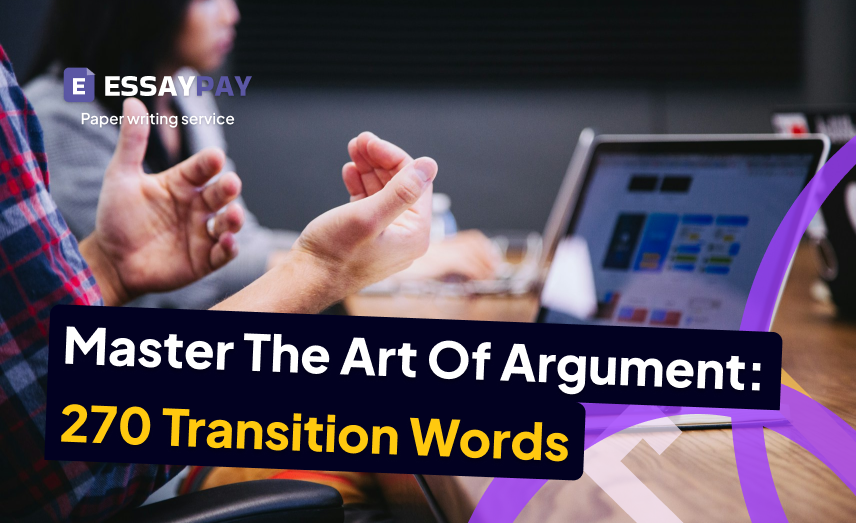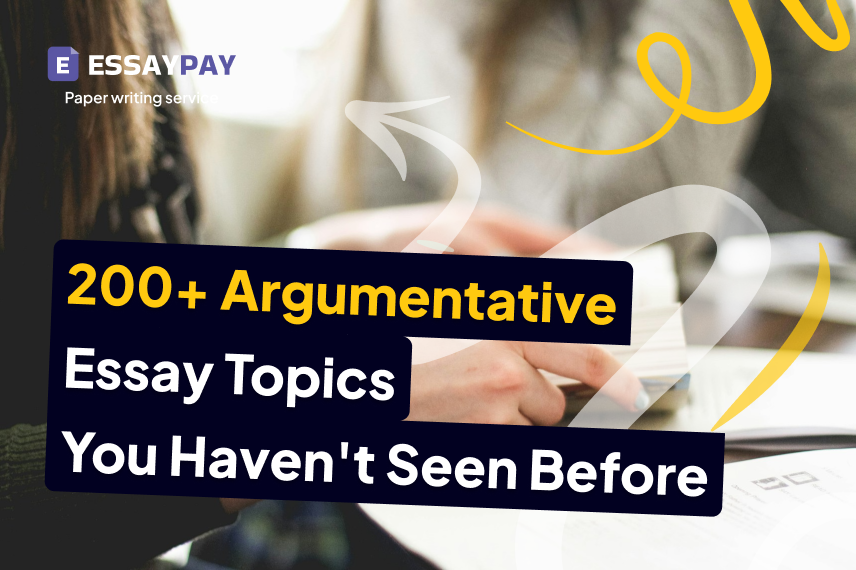When I first stumbled into college writing, I thought having a strong thesis was enough. Wrong. What professors really want is flow – how one idea bleeds into the next. That’s why transition words for argumentative essays matter so much: they make your paper feel polished instead of stitched together at the last minute.
And here’s a little secret: when I was overwhelmed and thought about paying for an argumentative essay writing service, what actually saved me wasn’t outsourcing – it was mastering transitions myself.
What Are Transition Words in Writing?
Simply put, they’re connectors. They turn fragments into a smooth journey. Think of them as the GPS of your essay. You can go from your transition words for argumentative essays introduction to the transition words for argumentative essays first body paragraph without confusing your reader.
Now, I won’t lie: the way schools teach this stuff can feel mechanical. But the real power comes when you pick transitions that fit the rhythm of your argument.
Why Are Transition Words Important in Argumentative Essays?
If you’re brainstorming argumentative essay topics, you’re probably already thinking about evidence and counterpoints. But here’s what often gets missed: even a brilliant topic can fall flat if it’s not connected with care.
- They Help Structure Your Argument. Good writers know how to map things. Paragraph transition words for argumentative essays give your paper that logical backbone.
- They Improve Clarity and Logical Flow. Without them, your ideas trip over each other. With them, they glide.
- They Make Essays More Persuasive. Strong transition words for argumentative essays turn decent arguments into sharp ones. They make your essay sound certain, not shaky.
How to Use Transition Words Effectively
When teaching the process of writing an argumentative essay, I always start with this: don’t treat transitions as decoration. They’re strategic.
Where to Place Them

- Start of a paragraph → great for transition words for argumentative essays to start a paragraph.
- Middle of a sentence → subtle pivot or contrast.
- End of a thought → teaser for the next point.
Mistakes to Avoid
- stuffing the same connector everywhere;
- using conclusion transition words for argumentative essays before you’ve actually finished;
- mixing formal and casual connectors in the same essay.
Categories of Transition Words and Phrases
There are thousands of transitions out there, but not every one belongs in an argumentative essay. The trick is knowing which ones actually improve persuasion, and which ones just clutter your paragraphs. Below is a practical breakdown of good transition words for argumentative essays, organized by their purpose.
Transition Words for Introduction
Opening an essay is like stepping onto a stage – you want to grab attention without tripping over your own words. Introductory transitions help your reader land smoothly in your topic.
| To begin with | As a first step | To kick things off |
| In the first place | To start | Setting the stage |
| Initially | First of all | Before anything else |
| At the outset | From the beginning | As the first point |
| Primarily | Leading off | Launching with |
| It starts with | As an opening | Commencing with |
| In the beginning | At first glance | To start with |
Transition Words for Adding Information
When you’re writing you’re not just listing facts – you’re building a complete narrative. The secret to making your text flow is to connect your ideas so smoothly that your reader moves effortlessly from one thought to the next. These phrases are the bridges that hold your arguments together.
| In addition | On top of that | Also |
| In conjunction with | Furthermore | Likewise |
| Together with | Equally important | Along with this |
| As well as | Added to that | Coupled with this |
| Coupled with | Moreover | Adding to this |
| Plus | Not only that | Alongside that |
| Similarly | Complementing this | Together |
Transition Words for Giving Examples
Examples make your essay tangible. They help the reader see exactly what you mean instead of floating in abstract claims.
| For example | To illustrate | In particular |
| For instance | Namely | As seen in |
| Such as | As an illustration | Such instances include |
| To demonstrate | Consider | Illustratively |
| Specifically | Take the case of | In other words |
| For one | Take, for instance | As an example |
| One clear example | Notably | Case in point |
Transition Words for Contrasting Ideas
Contrast brings tension and critical thinking to your essay. These transitions let you compare perspectives smoothly without sounding abrupt.
| However | In spite of | On the contrary |
| On the other hand | Whereas | By comparison |
| In contrast | While | Alternatively |
| Conversely | Nevertheless | Differently |
| Nonetheless | Still | Regardless |
| Yet | But | Unlike |
| Although | Even though | Despite |
Transition Words for Cause and Effect
Cause-and-effect transitions make your argument hit harder. These words help your reader follow your logic, making the cause-and-effect relationship crystal clear.
| Therefore | In order to | With the result that |
| Consequently | So that | In consequence |
| As a result | For | As a consequence |
| Accordingly | Because | The effect is |
| Thus | Since | The cause is |
| Hence | As | Due to |
| For this reason | Given that | Owing to |
Transition Words for Presenting Evidence
Evidence gives weight to your arguments. These words are your way of handing your reader the proof. They show your claims are solid because they’re based on facts, research or what the experts say.
| According to | As shown by | To prove |
| Based on | In support of this | As proof |
| Research shows | This is supported by | With respect to |
| Studies indicate | To confirm | In the case of |
| Evidence suggests | To illustrate | As a result of |
| Data reveals | For instance | As demonstrated by |
| The fact is | For example | It is clear that |
Transition Words for Making an Argument
These words help you assert claims with confidence. They turn observations into points that hit the reader convincingly.
| Because | Given that | Consequently |
| Since | Due to | Therefore |
| As | For this reason | Thus |
| In order to | With the result that | Hence |
| Accordingly | In short | In fact |
| In other words | For instance | To clarify |
| For example | To be specific | To summarize |
Transition Words for Addressing Counterarguments
Counterarguments show depth. These transitions let you acknowledge opposing views without weakening your stance.
| Admittedly | Still | Of course |
| Granted | However | Although |
| Concededly | Even so | Granted |
| It is true that | On the other hand | Be that as it may |
| Despite this | While | That said |
| Nevertheless | Whereas | It must be noted that |
| Nonetheless | In spite of | Though |
Transition Words for Drawing Conclusions
Your conclusion is the final note of your argument – it should resonate and leave a strong impression. These phrases are what you use to bring your ideas to a clean, powerful close, ensuring your reader understands the full weight of your message.
| In conclusion | Overall | Ultimately |
| To conclude | Finally | As a result |
| In summary | Therefore | In short |
| To summarize | Thus | Due to |
| To sum up | Hence | In essence |
| All in all | Consequently | For this reason |
| Lastly | In brief | In the final analysis |
Transition Words for Clarification
Sometimes ideas get messy. Clarification transitions make your meaning crystal clear without sounding repetitive or robotic.
| In other words | To put it another way | To elaborate |
| To clarify | That is to say | In essence |
| In simpler terms | Put differently | Basically |
| To rephrase | Simply put | Specifically |
| By this I mean | To be more precise | For clarity |
| For example | For instance | As a matter of fact |
| To demonstrate | In short | To sum up |
Transition Words for Emphasis
These phrases give your words authority. They’re what you use to highlight a crucial point and make sure it has the impact it deserves.
| Indeed | In particular | Unquestionably |
| In fact | Specifically | Assuredly |
| Certainly | Notably | To emphasize |
| Surely | More importantly | Crucially |
| Obviously | Of course | In other words |
| Clearly | To be sure | To reiterate |
| Undoubtedly | Without a doubt | Above all |
Transition Words for Sequence or Order
Essays are journeys. These words guide the reader step by step, keeping ideas organized and easy to follow.
| First | Following this | At last |
| Second | After that | In the end |
| Third | Before | To conclude |
| Next | Prior to | To summarize |
| Then | Meanwhile | First and foremost |
| Subsequently | Finally | Secondarily |
| Lastly | In the next step, | As a result |
Transition Words for Showing Similarity or Comparison
Drawing parallels strengthens arguments. These transitions highlight connections between ideas or evidence.
| Likewise | Just like | Mirroring |
| In the same way | Just as | In a similar vein |
| Equally | Like | In a similar way |
| In comparison | As with | Correspondingly |
| Similarly | In parallel | Another way to look at it |
| As well as | Both… and | In the same light |
| Alike | Relative to | Along the same lines |
Common Pitfalls with Transition Words

Even the most powerful transitions can work against you if you’re not careful. When you force them into awkward places, use the same ones over and over or simply drop them in everywhere you can. Your writing will feel clunky and forced instead of smooth and convincing. Here are the most frequent mistakes students make:
- Over-relying on argumentative essay transition words for essays without mixing styles. Using the same words repeatedly gives your writing a robotic tone. Professors notice this immediately.
- Neglecting variety in the transition words for argumentative essays last body paragraph.When you end every paragraph with the same phrases like in conclusion or therefore – it starts to sound like a broken record. The reader simply stops paying attention.
- You shouldn’t cram several conjunctions into one sentence at once. Saying “Moreover, furthermore, in addition” all at once makes your essay sound cluttered and unnatural.
- Ignoring context. Not every transition fits every argument. For example, “similarly” doesn’t work when presenting a counterpoint.
- You don’t always need a big, obvious transition. Sometimes all it takes are small connectors like as a result or in effect to guide your reader smoothly from one point to the next.
If the transitions sound forced, swap them with alternatives from your personal “transition word bank.” A few well-placed connectors will always beat a page full of repetitive words.
Just the main thing
After all, what is most important? Not the words themselves, but how they fit together. When you read a good text, it seems to lead you by the hand. You just feel that everything is in its place. Transitions are what turn a simple set of facts into a lively conversation with the reader. And that really makes a big difference.




